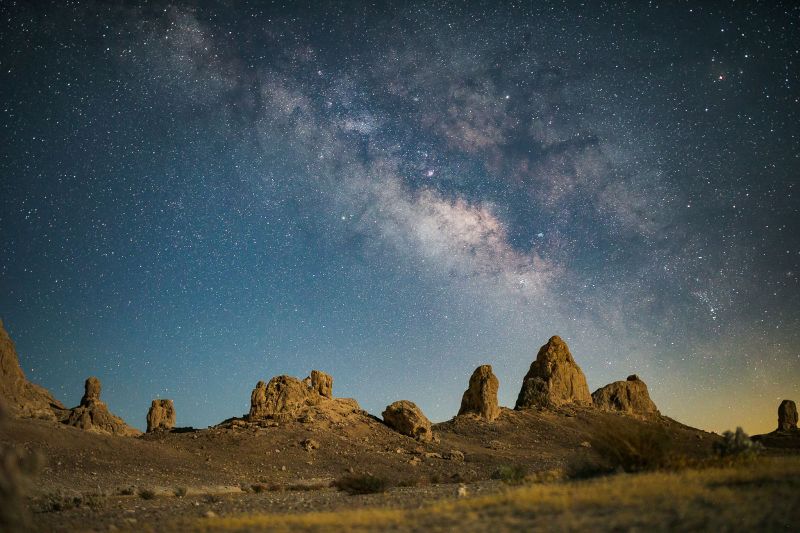
When it comes to Milky Way nightscape photography, the limiting factor is always light. Starlight isn’t bright enough to give you a strong ambient light source so you need as fast a lens as you can get. It is also important that the lens offers good wide-open image quality, since you may be using its fastest aperture often. With many lenses, it is difficult to focus on stars perfectly, due to the precision required on the focus ring, and with many autofocus lenses, even a fraction of a millimeter on the focus ring can be the difference between perfectly sharp and uselessly blurry stars. And while there is no one single lens that is best for milky way photography, there are a group of lenses that will work best for astrophotography compositions.
For a complete guide, see our article on How to Photograph the Milky Way. In this article, we’ll list the best lenses for milky way photography to consider for your adventures.
Zoom or Prime?
The answer is that both zoom and primes lenses have a place in your bag when photographing the milky way, or astrophotography in general. The more important question is, which focal length suits your personal style best? Which focal lengths offer compositions of the Milky Way above your nightscape scene?
Modern zoom lenses are often just as sharp as primes but are usually restricted to a maximum aperture of f/2.8. Due to the minimal ambient light in astrophotography, the faster apertures of primes (1.4, 1.8, 2.0) will allow you to run a shorter shutter speed and lower ISO improving the quality of the sharpness of your stars and the noise in your photo.
Here are our recommendations for both full-frame and crop sensor zooms & primes for all budgets and brands:
Best Crop sensor zoom lenses Lens for Milky Way photography
Tokina 11-20mm f/2.8 PRO DX
Tokina 14-20mm f/2.0 PRO DX
Sigma Art 18-35mm f/1.8
Best Crop sensor Prime lenses Lens for Milky Way photography
Rokinon 10mm f/2.8
Rokinon 12mm f/2.0 (mirrorless only)
Rokinon 16mm f/2.0
Best Full frame zoom lenses for Milky Way photography
Nikon 14-24mm f/2.8G ED
Canon EF 16-35mm f/2.8 III L
Tamron 15-30mm f/2.8 Di VC
Best Full frame Prime lenses for Milky Way photography
Sigma Art 14mm f/1.8
Rokinon 14mm f/2.4 SP
Rokinon 20mm f/1.8
Tokina 20mm f/2 (mirrorless only)
Rokinon 24mm f/1.4
Sigma Art 35mm f/1.4
Choosing Your Lens & Composition
Now that we’ve determined our best lens options for Milky Way photography, let’s discuss which focal lengths have which perspectives on the night sky.
From this infographic, we can see each focal length has a specific use for astrophotography. Reach for a lens in your kit based on what compositional elements you choose to incorporate in your photograph.
Take this image for example that was shot on a Sigma Art 35mm f/1.4. The foreground is being utilized as part of the composition of the frame, however, we lose the opportunity to see more of the sky and stars. This same image shot on at 14mm would most likely show too much ground.
Choosing the right lens for your composition depends on how much of the Milky Way Core you want to capture in your frame, after that you can decide what foreground elements would help create a stronger overall composition. Focal length is a subjective, creative decision, but generally speaking, most astrophotography is going to require a wide or ultra-wide lens.
Is The Sharpest, Most Expensive Lens Right For You?
Before we wrap up, a brief word on how to shop for the “best” lens, versus the “right” lens. Photographers often seem afraid of accidentally choosing an “inferior” option. A worthy concern, indeed, however, some people go too far and buy a lens that is heavier and/or much more expensive than they need, because they never use that focal length!
What people often don’t realize when shopping for what they think is the “best milky way lens”, is this: literally all wide-angle lenses that have come out in the last few years perform incredibly well in the central area of the image circle. If this general area (see the graphic below) is all you are worried about, then just pick a focal length and aperture that suits your personal style, and buy the most lightweight & affordable lens!

If you’d like a lens that delivers amazing sharpness for almost the entire image circle, (the yellow circle above is a rough approximation) but you’re still on a budget and/or would prefer a lens that doesn’t weigh 2-3 lbs, (1+ kg) …then no worries! There are still plenty of options that won’t break the bank or your back.
To be quite honest, it is only in the extreme, extreme corners (above, shaded red) where you will notice the truly “exotic”, fast-aperture lenses demonstrating a significant advantage over the less heavy/expensive ones.
So, simply ask yourself: what are my priorities? Aperture, weight, price, portability, and of course, corner sharpness. Just remember, it’s OK to prioritize some things more than others.
If an adventure photographer plans to capture the Milky Way from mountain peaks, and hike 10-20 miles a day, they may choose a lightweight option such as a Rokinon 14mm f/2.8 or Nikon 20mm f/1.8.
Each photographer will make their choices based on their personal priorities and preferences. There are some ultra-sharp, expensive lenses that are still relatively lightweight due to a more modest aperture. There are some lenses that are relatively affordable, and yet enormous, heavy, and indeed rather sharp.
So, make your decision based on your own personal priorities and preferences, and then just go out and make images!
Purchase photographing the milky way now!
Click the button below to purchase or stream it now in SLR Lounge Premium.
Matthew Saville
Follow his wilderness nightscape adventures on Instagram: instagram.com/astrolandscapes







Get Connected!